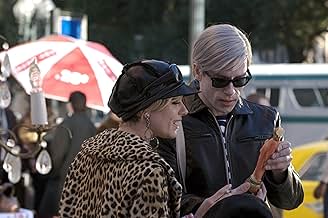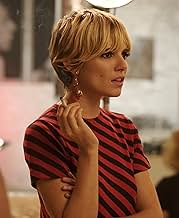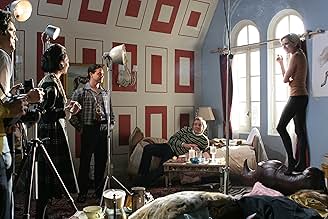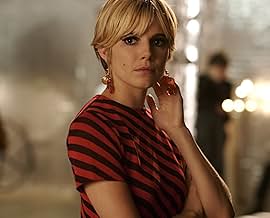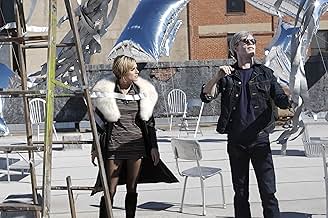Aggiungi una trama nella tua linguaBased on the rise and fall of socialite Edie Sedgwick, concentrating on her relationships with Andy Warhol and a folk singer.Based on the rise and fall of socialite Edie Sedgwick, concentrating on her relationships with Andy Warhol and a folk singer.Based on the rise and fall of socialite Edie Sedgwick, concentrating on her relationships with Andy Warhol and a folk singer.
- Premi
- 1 candidatura in totale
Trama
Lo sapevi?
- QuizSienna Miller improvised the scene in which Edie tells The Musician about her brothers' deaths.
- BlooperEdie Sedgwick's relationship to Nico is depicted incorrectly: in reality they were friends and Edie warned Nico about Andy Warhol's behavior. Edie's death was very sad for Nico.
- Citazioni
Andy Warhol: I wonder if people are going to remember us?
Edie Sedgwick: What, when we're dead?
Andy Warhol: Yeah.
Edie Sedgwick: Well, I think people will talk about how you changed the world.
Andy Warhol: I wonder what they'll say about you... in your obituary. I like that word.
Edie Sedgwick: Nothing nice, I don't think.
Andy Warhol: No no, come on. They'd say, "Edith Minturn Sedgwick: beautiful artist and actress...
Edie Sedgwick: ...and all-around loon.
Andy Warhol: ...Remembered for setting the world on fire...
Edie Sedgwick: ...and escaping the clutches of her terrifying family...
Andy Warhol: ...Made friends with eeeeverybody and anybody...
Edie Sedgwick: ...creating chaos and uproar wherever she went. Divorced as many times as she married, she leaves only good wishes behind.
[laughs]
Edie Sedgwick: That's nice, isn't it?
- Curiosità sui creditiDuring the first part of the end credits, photos are shown of the real Edie Sedgwick. Also people who knew her give testimonies about her.
- Versioni alternativeAccording to the FAQ section: "For the home theatre market, an unrated version was released aside from the R-rated theatrical version. Most scenes which were re-inserted or alternately shifted, serve to specify character drawings and various aspects of the story which were only embedded in the theatrical version to some extent. However, there are also a few extensions with sexual contents and more explicit depictions of drug use."
- Colonne sonoreDino's Song
Written by Chet Powers (uncredited)
Performed by Quicksilver Messenger Service
Courtesy of Capitol Records
Under License from EMI Film & Television Music
Guy Pearce delivers a very acceptable performance. Hayden Christensen, playing a fictional character so obviously meant to be Bob Dylan, is ludicrously weak, having none of the self-containment and gravitas of a great musician and poet, even a young one. Sienna Miller is a revelation, and worthier of a much better film than this one, which is flawed by poor conceptualisation. Even before it was completed, Factory Girl alienates the people who could have helped to make it great.
Some of the Factory denizens who bought into and eventually shared Warhol's artistic vision became products of his genius in a conscious way. They achieved independence and recognition in their own right. People like Paul Morrissey, the Velvet Underground (including Lou Reed, John Cale, and Nico). Edie Sedgwick, sadly, lost sight of the artist within her and never quite made it. She wanted to be famous - Warhol gave her that. She would have needed her own creative diligence to consciously realise what made her a star and so become autonomously successful.
To be fair to the film, the complaints, lawsuits and criticisms of the likes of Lou Reed and Bob Dylan seem without substance. The film does not blame Warhol or Dylan for Sedgwick's demise. The panda-eyed, drug-abusing wash-out that is the Sedgwick nearer the end of the movie does, but the audience can hardly say anything except she brought about her own downfall: she ingratiated herself to Warhol and his world when she was a nobody without even a job, then moaned that she couldn't work when he dumped her, when in fact she was obviously unemployable because of her drug habit.
The film's only real crime is perhaps that it celebrates the life of Edie rather than Andy, and that not particularly well. Seeing her at her height through the eyes of Andy Warhol would have achieved much more. Both 'sides' of the bitter split between the two of them agree she had, at one point, remarkable presence, charisma, and on screen talent. An occasionally more Warholian approach to the cinematography, while keeping the film accessible, could have emphasised such qualities with self-conscious camera-work and other devices. Instead, we have determinedly Hollywood-style continuity-editing. Warhol devices such as split-screen are used for window dressing rather than any discernible emotional impact. Similarly, variations in film stock pay lip service to a Warhol vibe rather than building an awareness of Edie's inner persona.
Warhol was not only the most famous exponent of Pop art, but one of the most important exponents of New American Cinema. His techniques influenced both Hollywood and experimental film, and his style affected censorship laws and developed the 'camp aesthetic' (defined by Susan Sontag as, "the love of the exaggerated, the 'off', of things being what they are not"). Factory Girl capitalises on the name, but is mainstream through and through.
If the producers had worked with people of real vision; if they had secured song rights for music by Velvet Underground and Bob Dylan (which would have helped establish historical and cultural context); if they had portrayed the beauty and sparkle of Edie Sedgwick through the eyes and genius of Warhol or someone like him; if they had made insightful recognition of her weakness and her greatness, then this could have been a work of art. For Warhol and Dylan enthusiasts it is full of Campbell's Soup Cans and shots reminiscent of album covers - but without depth. Some will see a slightly offensive depiction of Warhol as a bloodsucker (he didn't pay the experimental artists who gathered in his studio or appeared in his films). For more casual viewers it is a slightly poignant story of the rise and fall of a quintessential American IT girl in a Pop Art universe bursting with sex, drugs, art and rock 'n' roll. Factory Girl is Hollywood factory rather than Warhol Factory. But should it be decried because of that?
- Chris_Docker
- 13 mar 2007
- Permalink
I più visti
Dettagli
- Data di uscita
- Paese di origine
- Lingue
- Celebre anche come
- Fábrica de sueños
- Luoghi delle riprese
- Aziende produttrici
- Vedi altri crediti dell’azienda su IMDbPro
Botteghino
- Budget
- 7.000.000 USD (previsto)
- Lordo Stati Uniti e Canada
- 1.675.241 USD
- Lordo in tutto il mondo
- 3.572.632 USD
- Tempo di esecuzione1 ora 40 minuti
- Colore
- Mix di suoni
- Proporzioni
- 1.85 : 1
Contribuisci a questa pagina




